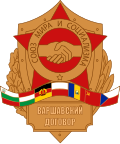
Back Republieke van die Sowjetunie Afrikaans جمهوريات الاتحاد السوفيتي Arabic Repúbliques de la Xunión Soviética AST Sovet sosialist respublikaları Azerbaijani Republik ring Uni Soviet BAN Спіс саюзных рэспублік СССР Byelorussian Сьпіс рэспублік СССР BE-X-OLD Съюзни републики на СССР Bulgarian Repúbliques de la Unió Soviètica Catalan Republiky v Sovětském svazu Czech
| Republics of the Union of Soviet Socialist Republics | |
|---|---|
 | |
| Category | Federated state |
| Location | |
| Created by | Treaty on the Creation of the USSR |
| Created |
|
| Abolished by |
|
| Abolished |
|
| Number | 15 (as of 1956) |
| Populations | Smallest: 1,565,662 (Estonian SSR) Largest: 147,386,000 (Russian SFSR) |
| Areas | Smallest: 29,800 km2 (11,500 sq mi) (Armenian SSR) Largest: 17,075,400 km2 (6,592,800 sq mi) (Russian SFSR) |
| Government | |
| Subdivisions | |
| Eastern Bloc |
|---|
 |
In the Soviet Union, a Union Republic ( Russian: Сою́зная Респу́блика, romanized: Soyúznaya Respúblika) or unofficially a Republic of the USSR was a constituent federated political entity with a system of government called a Soviet republic, which was officially defined in the 1977 constitution as "a sovereign Soviet socialist state which has united with the other Soviet republics to form the Union of Soviet Socialist Republics"[1][2] and whose sovereignty is limited by membership in the Union. As a result of its status as a sovereign state, the Union Republic de jure had the right to enter into relations with foreign states, conclude treaties with them and exchange diplomatic and consular representatives and participate in the activities of international organizations (including membership in international organizations).[3][4][5] The Union Republics were perceived as national-based administrative units of the Union of Soviet Socialist Republics (USSR).[6]
The Soviet Union was formed in 1922 by a treaty between the Soviet republics of Byelorussia, Russian SFSR (RSFSR), Transcaucasian Federation, and Ukraine, by which they became its constituent republics of the Union of Soviet Socialist Republics (Soviet Union). For most of its history, the USSR was a one-party state led by the Communist Party of the Soviet Union. Key functions of the USSR were highly centralized in Moscow until its final years, despite its nominal structure as a federation of republics; the light decentralization reforms during the era of perestroika (reconstruction) and glasnost (voice-ness, as in freedom of speech) conducted by Mikhail Gorbachev as part of the Helsinki Accords are cited as one of the factors which led to the dissolution of the USSR in 1991 as result of the Cold War and the creation of the Commonwealth of Independent States.
The Karelo-Finnish Soviet Socialist Republic, a relic of the Soviet-Finnish War (the Winter War), became the only union republic to be deprived of its status in 1956. The decision to downgrade Karelia to an autonomous republic within the Russian SFSR was made unilaterally by the central government without consulting its population.[citation needed] The official basis for downgrading the status of the republic was the changes that had occurred in the national composition of its population (about 80% of the inhabitants were Russians, Belarusians and Ukrainians), as well as the need to reduce the state apparatus, the cost of maintaining which in 1955 amounted to 19.6 million rubles.[7]
- ^ Article 76 of the 1977 Soviet Constitution
- ^ https://ru.wikisource.orgview_html.php?sq=Serbia&lang=en&q=%D0%9A%D0%BE%D0%BD%D1%81%D1%82%D0%B8%D1%82%D1%83%D1%86%D0%B8%D1%8F_%D0%A1%D0%A1%D0%A1%D0%A0_(1977)/%D0%A0%D0%B5%D0%B4%D0%B0%D0%BA%D1%86%D0%B8%D1%8F_07.10.1977#III._%D0%9D%D0%B0%D1%86%D0%B8%D0%BE%D0%BD%D0%B0%D0%BB%D1%8C%D0%BD%D0%BE-%D0%B3%D0%BE%D1%81%D1%83%D0%B4%D0%B0%D1%80%D1%81%D1%82%D0%B2%D0%B5%D0%BD%D0%BD%D0%BE%D0%B5_%D1%83%D1%81%D1%82%D1%80%D0%BE%D0%B9%D1%81%D1%82%D0%B2%D0%BE_%D0%A1%D0%A1%D0%A1%D0%A0
- ^ https://cyberleninka.ru/article/n/soglasie-ukrainskoy-ssr-na-obyazatelnost-dlya-nee-mezhdunarodnogo-dogovora-1
- ^ Article 80 of the 1977 Soviet Constitution
- ^ https://ru.wikisource.orgview_html.php?sq=Serbia&lang=en&q=%D0%9A%D0%BE%D0%BD%D1%81%D1%82%D0%B8%D1%82%D1%83%D1%86%D0%B8%D1%8F_%D0%A1%D0%A1%D0%A1%D0%A0_(1977)/%D0%A0%D0%B5%D0%B4%D0%B0%D0%BA%D1%86%D0%B8%D1%8F_07.10.1977#III._%D0%9D%D0%B0%D1%86%D0%B8%D0%BE%D0%BD%D0%B0%D0%BB%D1%8C%D0%BD%D0%BE-%D0%B3%D0%BE%D1%81%D1%83%D0%B4%D0%B0%D1%80%D1%81%D1%82%D0%B2%D0%B5%D0%BD%D0%BD%D0%BE%D0%B5_%D1%83%D1%81%D1%82%D1%80%D0%BE%D0%B9%D1%81%D1%82%D0%B2%D0%BE_%D0%A1%D0%A1%D0%A1%D0%A0
- ^ Hough, Jerry F (1997). Democratization and revolution in the USSR, 1985-1991. Brookings Institution Press. p. 214. ISBN 0-8157-3749-1.
- ^ Карелия во второй половине 1940-х — в 1960-е (Karelia in the second half of 1940s - 1960s) (in Russian)
© MMXXIII Rich X Search. We shall prevail. All rights reserved. Rich X Search